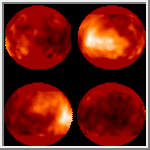|
COMETS EARTH JUPITER KUIPER BELT MARS MERCURY METEORITES NEPTUNE OORT CLOUD PLUTO SATURN SOLAR SYSTEM SPACE SUN URANUS VENUS ORDER PRINTS
PHOTO CATEGORIES SCIENCEVIEWS AMERICAN INDIAN AMPHIBIANS BIRDS BUGS FINE ART FOSSILS THE ISLANDS HISTORICAL PHOTOS MAMMALS OTHER PARKS PLANTS RELIGIOUS REPTILES SCIENCEVIEWS PRINTS
|
Related Document
Download Options
The map has been warped onto a globe and shown at four orientations. The top left is the Saturn-facing hemisphere (centered at 0 E) -- Titan is tidally locked so that the same side always faces Saturn (similar to the Earth's Moon and the Earth). The bottom left is the anti-Saturn hemisphere, where Saturn is never in the sky (180 E). The top right is the leading hemisphere (faces forward in Titan's orbit, 270 E), and the bottom right is the trailing hemisphere (90 E). As we watch Titan rotate from the Earth (or HST) we see the top left rotate into the top right, the bottom left, the bottom right, ... . Note that the longitudes given are in geographical, as opposed to astronomical, coordinates, so that east longitude increases to the right on maps. These images are a mosaic made from the original 850LP images (that is, the Hubble images have not been deconvolved). The total contrast is only plus or minus about 4% of the total light collected through the filter. The solid red-brick color at the top and bottom shows regions which could not be imaged through the haze (incidentally, this color shows the average intensity). The gap in coverage extends to the equator at about 10 deg longitude (top left) due to a 96 hour gap in coverage. University of Arizona, News Services
(Science contacts: Peter H. Smith, (602) 621-2725;
Mark Lemmon, (602) 621-1485;
UA Lunar and Planetary Laboratory)
|
